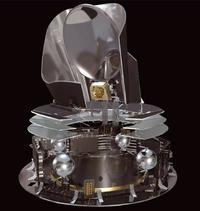-
Bill prohibits joint U.S.-China scientific activity
Language inserted into the 2011 spending bill would prohibit any joint scientific activity between the United States and China that involves NASA or is coordinated by the White House Office of Science and Technology Policy (OSTP); Rep. Frank Wolf (R-Virginia), the author of the prohibition, says: “China is spying against us, and every U.S. government agency has been hit by cyberattacks —- They are stealing technology from every major U.S. company. They have taken technology from NASA, and they have hit the NSF computers. —- You name the company, and the Chinese are trying to get its secrets”
-
-
U.S. Air Force wants mind reading aerial drones
The U.S. Air Force is currently working with several firms to develop aerial drones that have the ability to think and anticipate a controller’s actions before it occurs; the Air Force began exploring this capability in order to avoid collisions during takeoff and landings at busy airport terminals where both manned and unmanned planes launch; to address this problem, the Air Force awarded contracts to several firms to develop predictive software that can anticipate a pilot’s reaction if a drone is flying too closely
-
-
Bird-like visual sense to help UAVs navigate in urban environments

The U.S. Office of Naval Research (ONR) has awarded researchers $4.5 million to develop a bird-sized, self-flying plane that could navigate through both forests and urban environments; the plane would be about the size of a crow, and, like a bird, would use vision to navigate, but it would use orientable propellers and not flap its wings; the drone will rely, in part, on a technology that emulates the visual system of animals called Convolutional Networks, which mimics the neural network in the mammalian visual cortex and can be trained quickly to interpret the world around it
-
-
Space technology of practical uses on Earth

Terahertz technology developed for space missions to study the most distant objects in the universe is now finding a host of practical applications back on Earth; most clothing and packaging materials are transparent to Terahertz radiation, whereas skin, water, metal and a host of other interesting materials are not; this gives rise to some important day-to-day applications: detecting weapons concealed under clothing or inside parcels; distinguishing skin and breast cancer tissue; quality control of manufactures items and processes in factories
-
-
Rorschach test for terrorists

DHS wanted to test a Russian mind-reading technology which worked, more or less, like a Rorschach test for terrorists; developers of the method insisted that the technique was sound and objective; it is not clear what happened with the research work and whether or not it has yielded any practical results; neither the agency nor the institute contracted to do the work issued follow-up information
-
-
Army spends $50M for translation app that is already available

This year the Pentagon has set aside nearly $50 million for the development of a sophisticated smartphone translation app that would allow troops in Afghanistan to translate Pastho and Dari; but some troops have already begun using the SpeechTrans app to translate Arabic which can be downloaded on any iPhone or iPad for less than $20, and the New Jersey based company is hard at work on an Afghan language edition of its app; one defense analyst questions the need to spend millions on research when “good enough” technology is already available, especially in light of congressional efforts to cut the deficit
-
-
Understanding crowd behavior in disasters
Researchers have developed a new model for the behavior of pedestrians and crowds; most simulation software is often based on physics-inspired assumptions, such as repulsive forces between pedestrians; the new, psychologically based model, in contrast, assumes that pedestrians try to minimize the coverage of their vision field, while adjusting the walking speed to keep a safety distance from other people; the new approach can help in understanding and preventing tragic crowd disasters, developing better architectural designs and new navigation approaches in robotics
-
-
New rifle sighting system dramatically improves accuracy
Crosshairs automatically adjust for conditions in real time; a fiber-optic laser-based sensor system automatically corrects for even tiny barrel disruptions; the system, developed at Oak Ridge National Laboratory’s (ORNL), precisely measures the deflection of the barrel relative to the sight and then electronically makes the necessary corrections; the new sensor is 250 times better than that of traditional crosshairs, which can be manually adjusted by one-fourth minutes of angle; the ORNL sensor can sense angular displacement and shift the reticle (crosshairs) by 1/1,000th of a minute of angle
-
-
Brazilian police get biometric "Robocop" glasses
Facial-recognition glasses have been deployed by Brazilian police ahead of the 2014 World Cup soccer tournament; the system can scan and compare four hundred faces per second using 46,000 biometric points for comparison; the technology will be tested at public events leading up to the World Cup
-
-
Computerized irrigation system saves money

The University of Michigan is using a computerized irrigation system for its campus landscaping; the system uses information from a campus weather station that monitors wind speed, rain, temperature, and humidity to adjust irrigation schedules; the system allowed the school to reduce the amount of water used on irrigation by 22 million gallons of water on landscape irrigation each year — or 68 percent relative to the amount of water used before the system was installed — saving an estimated $141,000 a year
-
-
Dialing with your brain
Researchers have developed a device that allows individuals to make a cell phone call using only their mind; the gadget non-invasively analyzes an individual’s electrical activity in the brain and translates those pulses wirelessly to dial a cell phone; in trials, the system was able to achieve 100 percent accuracy in the majority of test subjects after a brief period of training; researchers originally designed the system to help severely disabled people, but believe that it has a broad range of applications
-
-
70-kg plane available for $39,000
A Finnish company is offering a personal plane for about $39,000; the plane weighs only seventy kilograms; wingspan is nearly five meters, nose to tail 3.5 meters, and height 1.3 meters. maximum take-off weight is 200 kilograms; speed range is 70-140 km/h with a service ceiling of three kilometers
-
-
Chips may sabotage hi-tech weapons
Countries producing sophisticated weapon systems do not want these systems to fall into the wrong hands; one idea is to plant a chip in these weapons which would allow the country that supplied them to destroy or disable them remotely; already there are worries that with chip manufacturing moving outside the United States, foreign powers may bribe or coerce chip manufacturers into planting “backdoor” circuits in chips these manufacturers sell American defense contractors
-
-
Rare Earth scientific breakthrough may increase their use
Rare Earth metals are a series of elements that represent one of the final frontiers of chemical exploration; the vigorous reactivity of these substances, however, has made it difficult for researchers to transform them into stable materials with well-defined structures; when researchers succeed, the payoff can be enormous — rare Earth compounds have important applications in areas ranging from catalysis to clean energy
-
-
3-D scanner iPhone app developed
A Georgia Tech researcher develops an iPhone app that allows users to take 3-D scans of faces or other objects and share them by e-mail; in the latest update, users can also e-mail animated videos of their 3-D models; “There are professional, $40,000 3-D scanners out there; this won’t perform like those do, but for anything under $100, this is your best bet,” says the researcher
-
More headlines
The long view
New Technology is Keeping the Skies Safe
DHS S&T Baggage, Cargo, and People Screening (BCP) Program develops state-of-the-art screening solutions to help secure airspace, communities, and borders
Factories First: Winning the Drone War Before It Starts
Wars are won by factories before they are won on the battlefield,Martin C. Feldmann writes, noting that the United States lacks the manufacturing depth for the coming drone age. Rectifying this situation “will take far more than procurement tweaks,” Feldmann writes. “It demands a national-level, wartime-scale industrial mobilization.”
How Artificial General Intelligence Could Affect the Rise and Fall of Nations
Visions for potential AGI futures: A new report from RAND aims to stimulate thinking among policymakers about possible impacts of the development of artificial general intelligence (AGI) on geopolitics and the world order.
Smaller Nuclear Reactors Spark Renewed Interest in a Once-Shunned Energy Source
In the past two years, half the states have taken action to promote nuclear power, from creating nuclear task forces to integrating nuclear into long-term energy plans.
Keeping the Lights on with Nuclear Waste: Radiochemistry Transforms Nuclear Waste into Strategic Materials
How UNLV radiochemistry is pioneering the future of energy in the Southwest by salvaging strategic materials from nuclear dumps –and making it safe.
Model Predicts Long-Term Effects of Nuclear Waste on Underground Disposal Systems
The simulations matched results from an underground lab experiment in Switzerland, suggesting modeling could be used to validate the safety of nuclear disposal sites.
